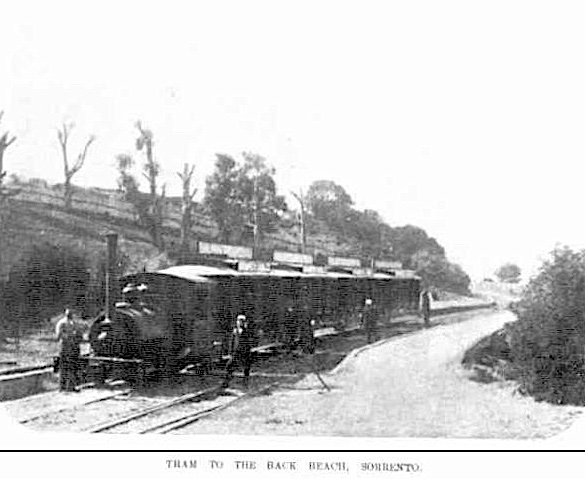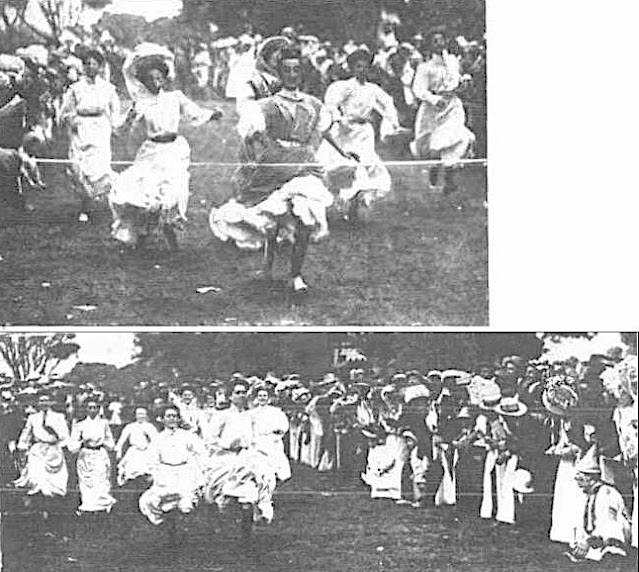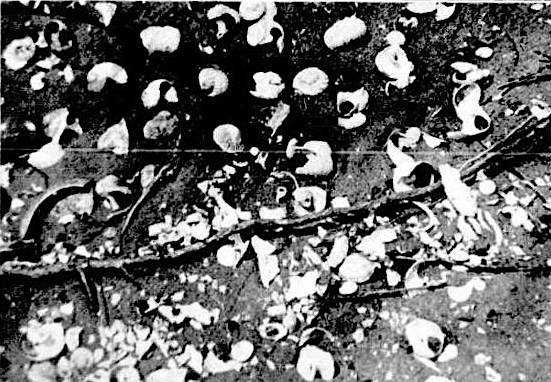At the western end of Sorrento Front Beach is Policemans Point and the Sorrento Pier.
The Bunurong Aboriginal People
On 16th October, the printing of the first news sheet occurred.
The Bunurong are part of the Kulin language group. Their traditional lands are from the Werribee River in the northwest down to Wilson's Promontory in the southeast.
Moving about according to the seasons, Bunurong people hunted and camped across the lands of the Mornington Peninsula. Important food sources were waterfowl, tortoises, fish, bulbs and roots.
 |
| British Library digitised image from page 982 of "De Aardbol. Magazijn van hedendaagsche land- en volkenkunde ... Met platen en kaarten [Deel 4-9 by P. H. W.]" British Library. Aboriginal woman often carried a child sitting on her shoulders |
"Tribes belonging to the Kulin nation lived on all the rivers rising in the Victorian Alps from the Yarra round northwards to the Ovens River." (1.)
The wetlands, bays and creeks of the area were used as camping areas, where the Bunurong people made temporary shelter's called mia-mia's from bark, branches, leaves and grass.
Three weeks later the French explorer Nicolas Baudin sailed through the strait from east to west.
Kangaroo and possum skins were used to make cloaks for the colder months. Cloaks were also wrapped around the body when sleeping and used for wrapping babies. One possum cloak that dates from 1853 is made from 83 possum skins.
Stone tools such as diorite (greenstone) axes were used for a variety of tasks, including butchering food, digging for tubers, chopping wood and removing tree bark, and processing vegetal materials.
The Bunurong peoples' totems are Bunjil the Eaglehawk and Waang the Crow.
Bunjil was the maker of the earth, trees, and men, and his name exists in the language as the term for wisdom or knowledge. (Edward Stone Parke
"Bunjil taught the Kulin the arts of life, and one legend states that in that time the Kulin married without any regard for kinship. Two medicine-men (Wirrarap) went up to him in the Tharangalk-bek, and he said in reply to their request that the Kulin should divide themselves into two parts—"Bunjil on this side and Waang on that side, and Bunjil should marry Waang, and Waang marry Bunjil." (2.)
The Kulin account is that the moon was once a man who lived on the Earth. He wished to give the old Kulin a drink of water, so that, when they died, they could after a time return to life again; but the Bronze-wing pigeon would not agree to this, which made the moon very angry. (M. E. B. Howitt, Legends and Folklore.)
The Bunurong people were often at war with the neighbouring Braiakolung and Brataolung people.
Evidence of long Aboriginal occupation of the land can be found in: scar trees, stone tool artefact scatters, coastal or freshwater shell middens, burial sites.
The first recorded encounter occured between the Aboriginal people and Europeans in Victoria 1802, with Lieutenant John Murray, RN, abroad HMS Lady Nelson.
"Fresh light airs inclinable to calm throughout this 24 hours. The boat (as mentioned in latter part of yesterday's log) proceeded to the shore and was as before received in a friendly manner by the natives, all of whom were seated in a circle on a beautiful spot of grass near a high point of land. Mr Bowen and all the crew consisting of 5 men and the boy, Mr Brabyn, went up with their dinners in their hands and sat down in the midst of them (18 in number) and began to eat showing the natives how to eat bread, etc., and gave them anything they chose to ask for. Mr Bowen gave them all the things I had sent as well as several of his own things - stripping himself almost naked to comply with their wishes, and his example was followed by the whole of the boat's crew. As there was two fine-looking boys amongst them I sent Mr Brabyn on shore purposely to see and gain their confidence by his attention to their youngsters, both of whom he dressed in his shirts, handkerchiefs, trowsers, etc."
"All matters continued in this state while our people had anything to give and all we got was a spears, a basket and a mogo and even these they again took from the seamen that had them in keeping, this however the officer took no offence at being determined if at all possible to keep on friendly terms with them. It was in vain that the officer and crew tryed by signs too significant not to be understood to gain intelligence where water was to be found or on what beaches shells were most plentiful, to all such enquiries they turned a deaf ear and only seemed intent on getting what our people had even to the last shirt; by this time our people had nearly finished their dinners and Isaac Moss having the boat in charge got up and was walking slowly down to her. At this time the Boy Brabyn happened to turn his head towards the wood and saw a man in the very act of throwing a spear at Moss as well as a large body (not before seen) behind a large fallen tree with their spears all in readiness for throwing. The boy immediately cried out to Mr Bowen who was at that very time in the act of serving out bread to all the party he was sitting among that he would be speared, but before the words were out of his mouth, a spear of a most dangerous kind, was thrown at and did not escape Moss by a yard and in an instant the whole of the treacherous body that Mr Bowen and 4 of our people were sitting in the midst of opened out to the right and left and at once left them all open to the party in ambush who immediately were on their feet and began to throw spears; still such was the forbearance of the officer that only one piece was fired over their beads but this was found only to create a small panic, and our party were obliged to teach them by fatal experience the effect of our walking sticks."
"The first fire made them run and one received two balls between his shoulders, still some of them made a stop to heave; the second fire they all set off with astonishing speed and most likely one received a mortal wound. Before another piece was fired Mr Bowen laid hold of one of their number and held on till three of our people came up and also grappled him, strange to tell he made such violent struggles as to get away from them all nor did the contents of the officer's piece bring him up although one ball passed through his arm and the other in the side - he was traced a good distance by his blood - the remaining pieces were by this time fired and our party gave chase to them all." Read here
According to Kulin people, the creation spirit, Lohan, created their territory. Lohan saw a swan’s feather carried by the wind, as he was cooking eels at the Yarra River (Melbourne). He followed the feather in the direction of Westernport Bay, where the swans lived, and when they migrated further to the east, he again followed them until he arrived in the mountains of Wa mung (Wilson’s Promontory) where he made his home (Howitt, 1904).
The Kulin account is that the moon was once a man who lived on the Earth. He wished to give the old Kulin a drink of water, so that, when they died, they could after a time return to life again; but the Bronze-wing pigeon would not agree to this, which made the moon very angry. (M. E. B. Howitt, Legends and Folklore.)
The Bunurong people were often at war with the neighbouring Braiakolung and Brataolung people.
A ceremony to protect Kulin people from clans living outside the marr ne beek (Lohan’s Country) from spiritual beings who may have been hostile to them, was required before entering this Country (Howitt 1904).
Lime was transported on small flat-bottomed barges to boats in the channel between Sorrento Pier and the Baths.
1802
 |
| The Lady Nelson replica "square rigged" brig's home port is Hobart, Tasmania |
Tuesday, February 16th:
".........At sundown a native fire was seen about a mile inland, in the morning early I sent Mr Bowen and Bond armed to speak them, neither fell in with them. At 9 A.M. hove up our Bower with a light air at N.E. and dropped a few miles further up the Port. We now saw the same fire just lighted by the natives and presently perceived several of them come out of the Bush, but the moment they saw the vessel they sprang into the wood out of sight. At 11 A.M. we came to an anchor in 5 fathoms water, handed sails, etc., as there was a native fire burning a little way inland."
"I sent the launch with Mr Bowen and 4 hands armed to see if any natives were here, and before the boat was half-way on shore we had the satisfaction of seeing 18 or 20 men and boys come out of the wood and seat themselves down on a green bank waiting the approach of our boat with which I had sent some shirts and other trifles to give them; the boat accordingly landed in the midst of them and a friendly intercourse took place with dancing on both sides - in an hour the boat returned. Mr Bowen had dressed them in our white shirts and invited them on board, this however they declined, but exchanged for all this. Got a basket of straw neatly enough made. They were all clothed in the skins of opossums and each had a bundle of spears, a stone mogo and one basket. They wished much to know what our arms were and their use and did not seem entirely to believe Mr Bowen that they were only walking sticks - no women were amongst them. I sent the boat again with some bread, looking-glasses, tomahawk and a picture as presents to induce them to part with their weapons and dresses as also to inform us where there was water. This day all hands put upon two-thirds allowance of bread."
Wednesday, February 17th:
"I sent the launch with Mr Bowen and 4 hands armed to see if any natives were here, and before the boat was half-way on shore we had the satisfaction of seeing 18 or 20 men and boys come out of the wood and seat themselves down on a green bank waiting the approach of our boat with which I had sent some shirts and other trifles to give them; the boat accordingly landed in the midst of them and a friendly intercourse took place with dancing on both sides - in an hour the boat returned. Mr Bowen had dressed them in our white shirts and invited them on board, this however they declined, but exchanged for all this. Got a basket of straw neatly enough made. They were all clothed in the skins of opossums and each had a bundle of spears, a stone mogo and one basket. They wished much to know what our arms were and their use and did not seem entirely to believe Mr Bowen that they were only walking sticks - no women were amongst them. I sent the boat again with some bread, looking-glasses, tomahawk and a picture as presents to induce them to part with their weapons and dresses as also to inform us where there was water. This day all hands put upon two-thirds allowance of bread."
Wednesday, February 17th:
"All matters continued in this state while our people had anything to give and all we got was a spears, a basket and a mogo and even these they again took from the seamen that had them in keeping, this however the officer took no offence at being determined if at all possible to keep on friendly terms with them. It was in vain that the officer and crew tryed by signs too significant not to be understood to gain intelligence where water was to be found or on what beaches shells were most plentiful, to all such enquiries they turned a deaf ear and only seemed intent on getting what our people had even to the last shirt; by this time our people had nearly finished their dinners and Isaac Moss having the boat in charge got up and was walking slowly down to her. At this time the Boy Brabyn happened to turn his head towards the wood and saw a man in the very act of throwing a spear at Moss as well as a large body (not before seen) behind a large fallen tree with their spears all in readiness for throwing. The boy immediately cried out to Mr Bowen who was at that very time in the act of serving out bread to all the party he was sitting among that he would be speared, but before the words were out of his mouth, a spear of a most dangerous kind, was thrown at and did not escape Moss by a yard and in an instant the whole of the treacherous body that Mr Bowen and 4 of our people were sitting in the midst of opened out to the right and left and at once left them all open to the party in ambush who immediately were on their feet and began to throw spears; still such was the forbearance of the officer that only one piece was fired over their beads but this was found only to create a small panic, and our party were obliged to teach them by fatal experience the effect of our walking sticks."
"The first fire made them run and one received two balls between his shoulders, still some of them made a stop to heave; the second fire they all set off with astonishing speed and most likely one received a mortal wound. Before another piece was fired Mr Bowen laid hold of one of their number and held on till three of our people came up and also grappled him, strange to tell he made such violent struggles as to get away from them all nor did the contents of the officer's piece bring him up although one ball passed through his arm and the other in the side - he was traced a good distance by his blood - the remaining pieces were by this time fired and our party gave chase to them all." Read here
As Britain was involved in the French revolutionary wars, Governor King was concerned that Bass Strait could harbour enemy raiders.
According to the explorer Hovel, Aboriginal women were taken by sealers. The sealing industry operated around Bass Strait from 1801 to 1830.
William Buckley, a convict from Macclesfield, England, in 1802, escaped from the British prison at Sorrento.
The first British settlement occurred at Sullivan Bay in October 1803, near modern-day Sorrento, under the command of Colonel David Collins, formerly judge-advocate of New South Wales, along with convicts, marines and free settlers, which landed at Sullivan Bay.
 |
| Photographic print of printing press supposedly used at Collins' Sorrento settlement, 1803-1804. The press was housed in Perth Public Library at time of photograph, likely 1932. State Library Victoria Collections |
The Sorrento settlement was a British base aimed at preventing French attempting to gain advantage. Interestingly, a confidential report from one of the explorers on the Nicholas Baudin expedition has revealed that French considered destroying the British colony. Read here.here
William Buckley, a convict, escaped from Sorrento and lived for more than 30 years with the Wathaurong people before approaching John Batman's party in 1835. Read John Morgan's The Life and Adventures of William Buckley as history
In September 1836, the Port Phillip land district was proclaimed open for settlement. European settlers then began quarrying and burning lime, fishing and agriculture.
In June 1839 John Fawkner was advertising Nepean lime for sale in Melbourne.
In 1852, the Boonwurrung people were allocated 340 hectares (840 acres) at Mordialloc Creek.
Point Nepean quarantine station operated from 1852 until it officially closed down in 1980.
Sir Charles Gavan Duffy (1816-1903), an Irish nationalist and Victorian statesman built a holiday house, at Point King, and named it Sorrento.
George Coppin, comedian, politician, philanthropist and businessman, took an interest in the development of Sorrento, where he had a seaside home.
1850s
1860s
Thirty-three years After William Buckley escaped from prison at Sorrento, a farmer came upon a white man speaking an Aboriginal language. This man had an extremely long beard and wore possum skins. Once the man learnt to speak English again, he informed the authorities that he was William Buckley and he had spent 33 years living with Aboriginal people.
Coranderrk Aboriginal reserve was operated by the Victorian government between 1863 and 1924, located around 50 kilometres (31 mi) north-east of Melbourne. The residents were mostly, Woiwurrung, Bunurong and Taungurong peoples1870s
In 1870 George Coppin chartered a paddle steamer and took a group of businessmen to Sorrento to show them the area's potential. The padlesteamer ran aground, and the group landed with rowing boats.
In 1871, the Census showed that Sorrento, including Portsea, had 22 occupied houses with 98 inhabitants.
Sorrento Hotel, a limestone and brick hotel, was built in a number of stages from 1872 for P.J. Martin.
PS Williams was a passenger steamer and tug that charged £1 for a return ticket to Sorrento. It commenced running to Sorrento on 9th November, 1872.
Coppin's Ocean Amphitheatre Company constructed a road to the back beach, and a large rotunda in 1874. The company also built the front beach sea baths.
The Sorrento and Queenscliff Steam Navigation Company (also Coppin), bought the Golden Crown paddle steamer, which transported 2000 visitors Melbourne in its first season. Latter paddle-streamers were Ozone, the Hygeia and Weeroona.
Sorrento was becoming a popular holiday resort for moneyed Melbourne people.
George Choppin sponsored the Mechanics’ Institute built in 1877.
While holidaying at Sorrento, 24 January 1885, Nellie Melba organised a concert to provide a new fence for the cemetery, singing, The Angel at the Window (Tours) and Sing, Sweet Bird (Ganz), and raising £20 for the cause. (3.)
 |
| Sorrento from the steamer, VIC, SLVIC |
George Coppin's companies bought land in the centre of Sorrento, and he built the Continental Hotel in 1875. A horse-drawn tramway took passengers from the ferry up the hill to the hotel.
1880s
 |
| Continental Hotel, Sorrento, VIC, c. 1880-1885, was built in 1875 of locally quarried limestone. State Library of Victoria |
1890s
 |
| STEAM TRAM. SORRENTO, VICTORIA. 1890 |
 |
| The Pier, Sorrento, Victoria, circa 1890s. |
 |
| Group of men and a woman on the pier at Sorrento, steamer in dock. Victoria, 1890's/ 1910. |
 |
| "Hygeia" and passengers at the pier, Sorrento, Victoria, circa 1890/1910 |
 |
| Sorrento Hotel, Sorrento, Victoria. Melbourne Weekly Times. December 23 1899 |
1900s
The Whitehall Guesthouse was constructed in 1903/04 by James Allen and had accomodation for 100 guests.
 |
| George and Lucy Coppin in front of the private theatre they had built at their house the 'Anchorage' at Sorrento, Victoria, ca. 1901, NLAUST |
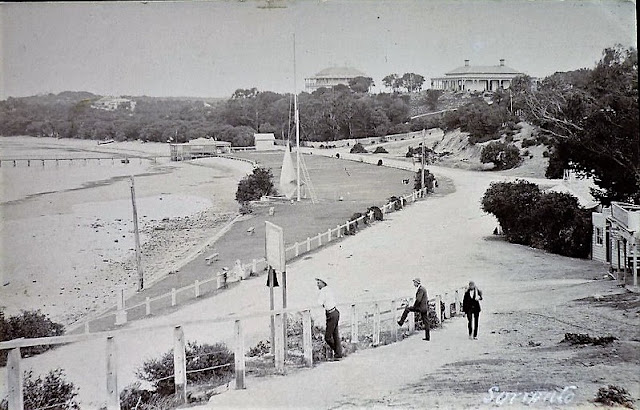 |
| Sorrento beach, Victoria - very early 1900s, Kaye |
 |
| The Hygeia on her way to Sorrento, VIC, Punch (Melbourne, Vic. : 1900 - 1918; 1925), Thursday 22 December 1904 |
 |
| View of Front Beach, Sorrento, VIC, Punch (Melbourne, Vic. : 1900 - 1918; 1925), Thursday 22 December 1904 |
 |
| The Ozone at the pier, Sorrento, VIC, Punch (Melbourne, Vic. : 1900 - 1918; 1925), Thursday 22 December 1904 |
 |
| View of the pier, Sorrento, VIC. Punch (Melbourne, Vic. : 1900 - 1918; 1925), Thursday 22 December 1904 |
 |
| Watching the races, Sorrento, VIC, Punch (Melbourne, Vic. : 1900 - 1918; 1925), Thursday 2 March 1905 |
 |
| Georgina Wardell sitting outside "Ivanhoe", Sorrento, VIC, 1905, SLVIC |
 |
| Women washing up outside a building, Sorrento, Victoria, ca. 1900 - ca. 1910, State Library Victoria Collections |
 |
| Off to Back Beach, Sorrento, VIC, Leader (Melbourne, Vic. : 1862 - 1918, 1935), Saturday 27 February 1909 |
 |
| Whitehall' at Sorrento, Victoria - 1910, Kaye |
 |
| POST OFFICE EMPLOYES' PICNIC AT SORRENTO, VIC, Punch (Melbourne, Vic. : 1900 - 1918; 1925), Thursday 23 February 1911 |
 |
| POST OFFICE EMPLOYES' PICNIC AT SORRENTO, VIC, Punch (Melbourne, Vic. : 1900 - 1918; 1925), Thursday 23 February 1911 |
 |
| MEMBERS OF THE LADIES' WELSH CHOIR At the Welsh picnic held at Sorrento on St. David's Day. Punch (Melbourne, Vic. : 1900 - 1918; 1925), Thursday 11 April 1912 |
 |
| The Sorrento Tramway commenced operations in 1890, running tourists from a platform cut into the cliffside overlooking the pier ~ through the centre of town ~ to the ocean or "back beach", SLVIC |
 |
| Sorrento Hotel at Sorrento, Victoria - 1914, Kaye |
WWI
The fortifications at Fort Nepean helped protect Melbourne during World War I and II. It is 10 minutes drive from Sorrento to Point Nepean National Park, where you can Explore military forts and tunnels.
During World War II, Whitehall Guesthouse was made available to families of servicemen by the Royal Australian Navy (RAN). It later became a Migrant Workers’ Hostel.
 |
| Whitehall Guesthouse and The Back Beach Palace Sorrento, VIC, 1914 |
ROLL OF HONOUR
Albert George Hibbert
|
Service number |
706 |
|
Rank |
Lance Corporal |
|
Unit |
31st Australian Infantry Battalion |
|
Service |
Australian Imperial Force |
|
Conflict/Operation |
First World War, 1914-1918 |
|
Conflict Eligibility Date |
First World War, 1914-1921 |
|
Date of Death |
21 July 1916 |
|
Place of Death |
France |
|
Cause of Death |
Killed in action |
|
Place of Association |
Sorrento, Victoria, Australia |
|
Cemetery or Memorial Details |
VC Corner Australian Cemetery and Memorial, Fromelles, Lille, Nord Pas de Calais, France |
|
Source |
AWM145 Roll of Honour cards, 1914-1918 War, Army |
 |
| Bendigo Advertiser (Vic. : 1855 - 1918), Friday 31 December 1915 |
1920s
The last tram operated at Easter in 1921.
 |
| Daily News (Perth, WA : 1882 - 1955), Saturday 13 March 1920 |
1930s
 |
| Mornington (Koonya) Hotel on the left and Clark's cottage behind the white picket fence, Sorrento, VIC, 1939 |
 |
| George Coppin's companies bought land in the centre of Sorrento, VIC, and he built the Continental Hotel in 1875. 1930s |
1940s and WWII
 |
| Lounge & Ballroom, "Romany Lodge", Sorrento, Victoria - circa 1940s, Kaye |
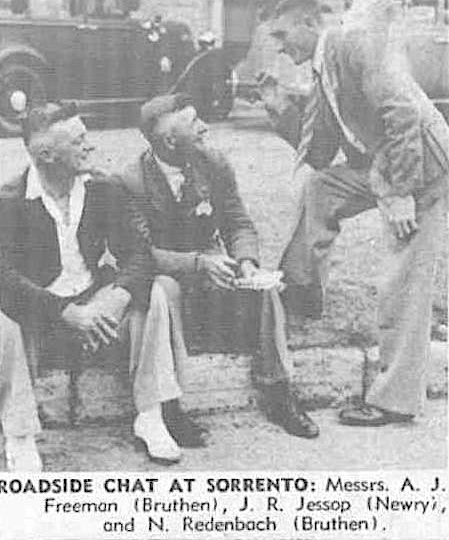 |
| Roadside chat at Sorrento, VIC, Australasian (Melbourne, Vic. : 1864 - 1946), Saturday 29 March 1941 |
 |
Back Beach Road, Sorrento, VIC, Weekly Times (Melbourne, Vic. : 1869 - 1954), Wednesday 11 July 1945 |
 |
| Sorrento, VIC, Argus (Melbourne, Vic. : 1848 - 1957), Wednesday 2 January 1946 |
 |
RETURNED MEN BASK IN SUNSHINE at Sorrento Rest House where tariff is £2/10/ a week for a fortnight's stay. Argus (Melbourne, Vic. : 1848 - 1957), Tuesday 21 May 1946 |
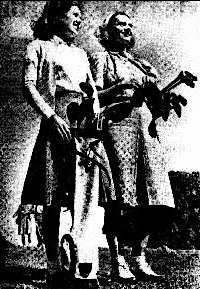 |
| SORRENTO GOLE CLUB LADIES DAY Holiday Tournament Opens. Age (Melbourne, Vic. : 1854 - 1954), Saturday 25 January 1947 |
1950s
1960s
In October 1967, the Historical Society opened the Sorrento Museum in the Mechanics' Institute.
1990s
Hotel Sorrento is a 1995 Australian drama film based on Hannie Rayson's play.
A re-enactment of the landing of Victoria's first European settlers 200 years ago took place at Sorrento.
2003
2020
Around Sorrento
 |
| The Athenaeum theatre was built in 1894 in the commercial centre of the seaside town of Sorrento, which became a popular destination in the 1880s. Designed by Melbourne architect, J. F. Gibbins |
 |
| Watts Cottage, Sorrento, VIC. Built in 1869 from 'wattle and daub' with roof shingles cut from trees at Arthurs Seat and a dirt floor |
 |
| Dalwhinnie, Sorrento, VIC, was built by the Sorrento Tramway Company in 1913 |
 |
| Melbourne Road, Sorrento, VIC |
 |
| Sorrento House, Sorrento, VIC, is a Federation Arts and Crafts house built 1915 |
 |
| Westbank, Sorrento, VIC, built 1910 |
 |
| The former home of Local builder James W Tayton and his workshop, store was once here. The original residence was constructed in 1906, Sorrento, VIC |
 |
| The Koonya Hotel in Sorrento, VIC, was originally named the Mornington Hotel when it was built in 1876 |
 |
| 200 Ocean Beach Road, Sorrento, VIC, was built by James Tayton in an almost Art Nouveau style |
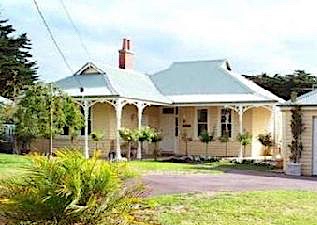 |
| Larnoo (1911), 19 Darling Road, Sorrento |
 |
| Former defensive facility, Fort Nepean, VIC |
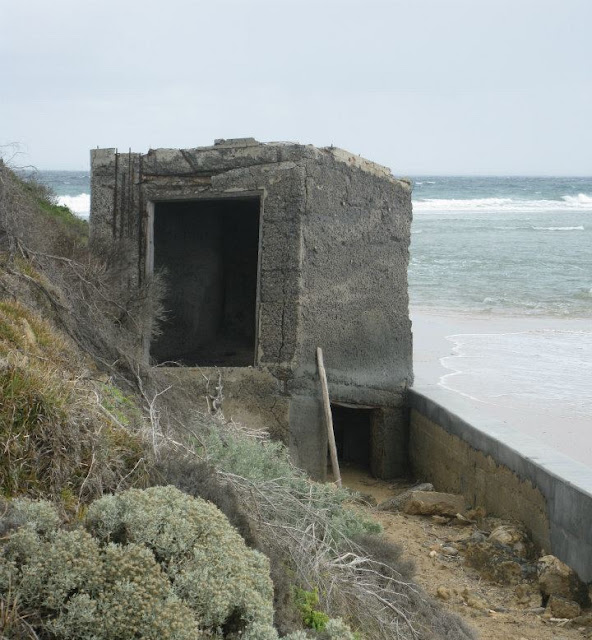 |
| Former defensive facility, Fort Nepean, VIC |
 |
| Former defensive facility, Fort Nepean, VIC. Preserved barrel 1489 which fired the first shot of World War I. To the left is barrel 1317 which fired Australia's first shot of World War II. |
 |
| Point Nepean Quarantine Station, VIC |
Things To Do and Places To Go






